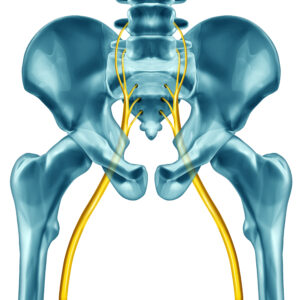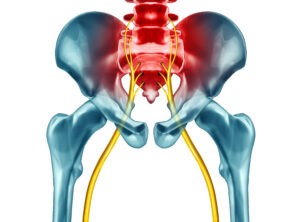Have you ever experienced sciatic pain?
The first time that I experienced sciatic pain, I was pregnant. My baby would move and then suddenly I would have a sharp shooting pain running down my leg. Occasionally I wondered if it would make me fall which scared me a bit as I was pregnant and I did not want to do anything that might hurt my baby. It was challenging to deal with, but in my case it was only a temporary side effect of being pregnant. Sciatica can be much longer lasting than what I experienced.
The sciatic nerve runs from the low back through the hips and down both legs. When this nerve gets pinched it causes pain anywhere from the low back to the buttocks, and down either leg. This pain could be mild and feel like a modest ache or some tingling or numbness or it could be severe and feel like a sharp shooting pain or a burning pain.

The most common causes of sciatica are having a herniated disk or a bone overgrowth or spur. There is a connection to osteoporosis here. When a person has osteoporosis the bones in the spine lose density and this can lead to degeneration of the joint cartilage between the discs. This may lead to the discs rubbing against each other, also known as having bone rub on bone. In an attempt to protect itself, the body actually produces more bone in this area and a bone spur may develop. The bone spur could potentially pinch the sciatic nerve causing pain.

There is also another possibility with osteoporosis that can lead to sciatic pain. In this scenario a person with osteoporosis experiences one or more compression fractures in their spine and the compression fractures themselves press against the sciatic nerve causing sciatic pain.
If your sciatica is more long term, you may be wondering what you can do and if there are ways to ease sciatic pain. Here are four ways that you can ease sciatic pain:
- Alternate cold and hot presses on your sciatic nerve at your low back. Start with a cold compress to lower inflammation along the sciatic nerve. Lay on your stomach and place a bag of frozen vegetables on your low back across your spine. Next switch to a hot compress which will help to increase blood flow and ease sciatic pain.
- Go for a short walk with good posture. (Walk for about 10-15 minutes) Even if it is a bit painful, walking can stimulate blood flow which can ease sciatic pain.
- Soak in a hot tub or go for a swim. This is another way to encourage blood flow and to ease sciatic pain. Swimming takes pressure off of your back. Keep in mind that swimming can be wonderful, but it does not have the weight bearing element needed in exercise to contribute to healthy bones as a regular form of exercise. You can still enjoy a relaxing swim and ease sciatic pain even if it does not contribute to building stronger bones. 😃
- Stretch. Yoga practiced in a bone safe way can be a wonderful way to stretch which eases sciatic pain. In an acute onset of sciatic pain it is helpful to stretch the hip flexors, hamstrings, and glutes to ease sciatic pain. Mild back bends are also helpful for providing good support for the spine which can help to ease sciatic pain over the long haul.
If you are interested in trying out a bone safe practice that is designed to ease sciatic pain check out Yoga for sciatica when you have osteoporosis with Sarah Mapes from The Bone Builder System.
If you would like to learn more about osteoporosis and what you can do to improve your bone health please subscribe to The Bone Builder System email list.
Sources
https://www.health.harvard.edu/pain/sciatica-of-all-the-nerve



